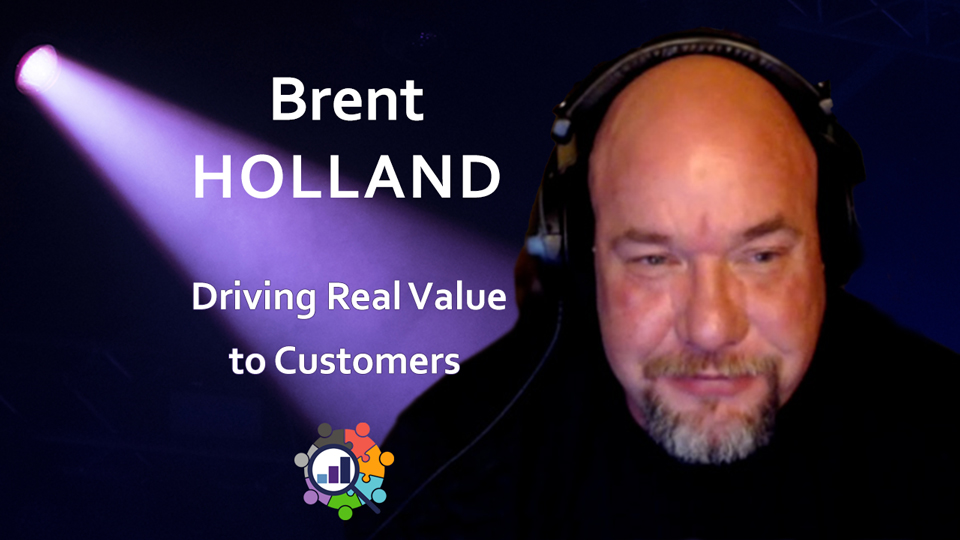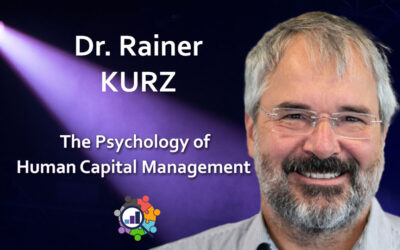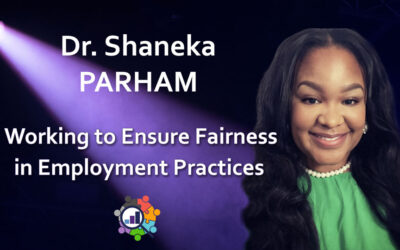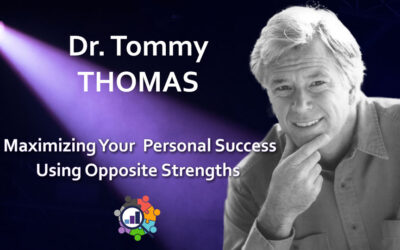A CykoMetrix Spotlight Production
Every week, the Spotlight shines on an amazing professional with a story to tell and lessons to teach. Welcome to the CykoMetrix Spotlight.
The following is an adapted transcript of the exchange between Sylvain Rochon, CMO at CykoMetrix as host, and Brent Holland, Founder & CEO of Intelliante.
Sylvain Rochon: Welcome to CykoMetrix Spotlight. My name is Sylvain Rochon, the chief marketing officer and co-founder of CykoMetrix, a leading edge combinatorial psychometric and human data analytics company that brings the employee assessment industry to the cloud with instant assessments, in-depth analysis, trait measurements, and team based reporting features that simplify informed decision-making around recruiting, training, and managing today’s modern workplace. Today, I have with me Brent Holland. He is the founder and CEO of Intelliante. He’s worked in the talent assessment and selection industry for 25 years. So, a well seasoned veteran. He has a PhD in industrial and organizational psychology from the University of Tulsa. He’ll be with me today talking about how to drive real value for customers. A very interesting topic. Thank you for being here, Brent.
Brent: My pleasure.
Sylvain: So, let’s dive right into it because this is straight to the point. Companies, what do they want? Well, they want to make their customers happy so that the customers buy their product or service. All right? So, how do you do that? How do you drive sales? You insist on the word, the real value. So, what is that and how do you do it?
Brent: I’ll approach this from the perspective of the talent assessment industry. The industry itself has, in my view, failed the customer. Companies spend more money today on HR tech, especially talent assessments, than ever. Yet, we continue to see CEOs decry the problem of not having enough or the right talent. So, it begs the question, if the talent assessment industry is working and doing what it purports to do, then why are these problems still here? My view is that, to create value for customers, we have to define the quality of hire in terms of job performance, retention, and ROI.
Sylvain: So, here’s the big question to me, all right? I kind of know the answer because we’re in the biz, but the audience may not. I want to have your perspective. What is the problem? Is it the deployment of the new tools and technologies, or is it the application and deployment of such, or how we interpret results? Where is the problem, where’s that gap where executives don’t get the results they need?
Brent: Everybody has a perspective on this, and marketing teams have done a good job minimizing the issue. But in the end, I don’t think the problem is a measurement issue. I believe that there are a lot of well-respected assessment organizations that try to implement good products and follow proper scientific protocols. I think it’s a connectivity problem; it’s a stickiness problem. In other words, the question becomes how, after you have implemented an assessment, do you continue to ensure connectivity between your hiring process and the job as it evolves over time? As an industry, it’s not a problem that we’ve tried to address, frankly, and we’re seeing the impact today. So, we show great results and good science, companies buy our products, and we implement solutions. Six months later, they’re saying, “Why isn’t this working the way you told me it would? Part of it may be a measurement problem for some companies, but the bigger problem is that the job itself has probably shifted, and the hiring process hasn’t kept pace with the changes.
Sylvain: So, what’s the solution for companies? It can vary case by case depending on shifts and whatnot, but what can the industry do to bridge that gap?
Brent: Well, I describe that issue as the rear-view mirror problem. When we think about the assessment industry, in a lot of ways, it’s rearward-facing. In other words, when we validate a test and show that the test predicts job performance, that job performance happened in the past. By definition, we’re looking behind that instead of in front of us. Well, once we implement, we’re already behind the curve in some cases three, six, twelve months. Depending on how far back those performance data go. The question then becomes: Is the job already starting to shift? So, we’re already behind. One thing we can do to solve the problem is to create mechanisms that allow us to pull a company’s performance data on their employees directly into the process. So, we’re never going to eliminate backward-facing processes, but we can reduce the lag. So, we can go from 12 months to 30 days relatively easily. In solving that problem, we’re always keeping the hiring process contemporary. It’s always connected to what’s happening in the actual job. That, ultimately, is how you create long-term value that will drive results for the applicant and the customer.
Sylvain: Are there any tools out there, like you mentioned, more modern tools that facilitate that for both the HR or executives and also the consultants that make it easy for that continuous evaluation cycle? Like you said everything kind of changes over time, the team’s change and the job description sometimes. What are the tools that exist right now that allows you to do that more effectively?
Brent: Well, I think there are two answers to the question. First, I believe there are a lot of well-funded marketing teams around the world that say that they do these things today. But, when you look at what they’re doing, it’s a bit of vaporware, to be honest. I don’t think many active implementations connect post-hire and pre-hire processes. Frankly, to my knowledge, I don’t know of any solution that is automated and scalable in an efficient way. The processes I’m aware of are manual and break because they’re using legacy data models. So, every time a customer decides to change the data structure, the process breaks. Ultimately, for us, this represents the opportunity I’m trying to solve through Intelliante.
Sylvain: Right. Well, tell me about that then. What is your solution at Intelliante to solve that problem? What does that look like?
Brent: So, the first problem you have to solve is multi-tenancy. In other words, how can we create a flexible infrastructure that supports multiple customers’ data models that are hierarchical in nature. Even within a company, it’s rare to find a unified data model. Oftentimes, they have multiple data models. That’s the first problem you have to solve. It’s the ability to absorb customer data in different structures and formats and to be able to organize the information into a unified model. We have approached the problem from our experience working with the contact center industry. We haven’t completely solved that problem in a fully automated way yet, but we can deploy our solution more rapidly than most other companies in the world.
The second problem that you have to solve is automating the analysis. In other words, I’m conservative because I believe in science. I mean, we know and see today the increased awareness that fairness, diversity, equity inclusion, and other initiatives are having. I think it’s due time for those things. But ultimately, being able to deploy solutions that support those initiatives comes down to good science. The question then becomes, how can you deploy science efficiently and in ways that allow customers to be consumers of that scientific output at a price point that makes sense? Organizational psychologists and data scientists are so expensive. So, we have to make it accessible. My view is automation. By solving the front-end problem, the multi-tenancy problem, making sure that we’re able to create unified data models within my environment. Now, that also allows me to automate the science in a way that gives results back to customers in a digestible format that is understandable, clear, and fast.
Sylvain: That sounds pretty amazing. You mentioned you still have some kinks in the solution that needs to be ironed out. It’s always a work in progress. There’s no perfect solution unless you declare it, which would be a very surprising. So, can you give me an example of a use case? For example, somebody or maybe a client that has had an issue, you went in there. Could you tell the audience of how it worked out for them.
Brent: Yeah, sure. Intelliante is premarket. So, we’re working with data customers now. But what I can do is I can share with you some examples where we have proven this concept in the past. My go-to-market is the contact center industry. It’s an industry I’ve worked in for the last 17 years. Frankly, I love that space because it’s such a challenging environment. The problems that exist are fantastic because they’re important and impact lots of people in significant ways. One of the interesting problems about that industry is that you have situations where you have multiple types of jobs, whether voice, chat, or social media monitoring. You have various locations. You may even have situations where there is a hub and spoke model where a corporation has multiple outsourcers globally. So, how can we solve their problems across those different use cases? Well, let’s take the example of a hub and spoke model. Let’s imagine we have a corporate customer with 20 partners globally supporting its business. By creating unified data models, you’re automating analysis within those unified data models across those 20 partners. You can create a single source of truth back to share with the corporate customer so that they can compare their partners on an apples-to-apples basis.
Now, they can see (and evaluate) how each partner performs on the metrics that matter to them. They can see how those partners are performing on attrition. They can see whether or not they’re delivering a standardized level of customer engagement. We generally see these deployments produce performance gains in the range of 20% to 30%. You can also see significant reductions in attrition that often exceed 50%. Again, it is because you are standardizing this process and creating a direct line of sight that looks beyond these historical barriers to that visibility.
Sylvain: Those are pretty significant numbers. You’re looking at whether he is at 20% to 30% more productivity and attrition reduced by 50%. That’s massive for contact centers. I’ve never worked in contact centers, but I have clients that have. They’ve been telling me sometimes the turnover rate annually is 100% and 120%.
Brent: Yes.
Sylvain: I mean, it’s nuts. Compared to other industries, of course, these are crazy numbers. So, attrition is a huge problem. The results basically speak for themselves is what I’m saying, right? How do companies engage with you to acquire your services and get started to drive real value.
Brent: That’s right. Customers can go to Intelliante.com. From there, they’re able to sign up directly, and what I’ve done is make that onboarding process simple and as drag free as possible. What are customers able to do? They can sign up for their account and complete the implementation online. They can conduct a job analysis. They will be able to complete the validation process independently of external consultants. We walk them through all the steps they need. They will even be able to create applicant workflows. It becomes a process that distinguishes them in the market. In the end, they’ll be able to complete the setup and launch a solution as quickly as their people go through the job analysis and validation processes. If they’re ready today, they could launch a validated solution this afternoon and be up and running immediately.
Sylvain: Well, you know what? That sounds amazing. I don’t see how else we can finish this talk but with as nice value proposition. It was like, “Hey, come to our site, get all this.” This stuff helps getting started more effective. Once everything is done, the staffs’ happier, more functional, more effective. All this because of less attrition. All things that should be music in the ears of CEOs everywhere and also the CFOs of companies, and HR departments and whoever else is involved. Thanks so much, Brent, for illuminating the challenges, and then here’s a solution. Something that remains a work in progress because it always is and it should be, but something that does statistically drive real results. So, thanks a bunch to be on the Spotlight to tell us about this.
Brent: Absolutely, my pleasure. Thank you for having me.
About Brent Holland – www.intelliante.com
Brent Holland is the founder and CEO of Intelliante, Inc., a performance-driven hiring platform that uses self-learning technology to match applicants with jobs more accurately over time while reducing friction, frustration, and cost.
About CykoMetrix – www.CykoMetrix.com
CykoMetrix is a leading edge combinatorial psychometric and human data analytics company that brings the employee assessment industry to the cloud, with instant assessments, in-depth analysis, trait measurements, and team-based reporting features that simplify informed decision-making around recruiting, training, and managing today’s modern workplace.



